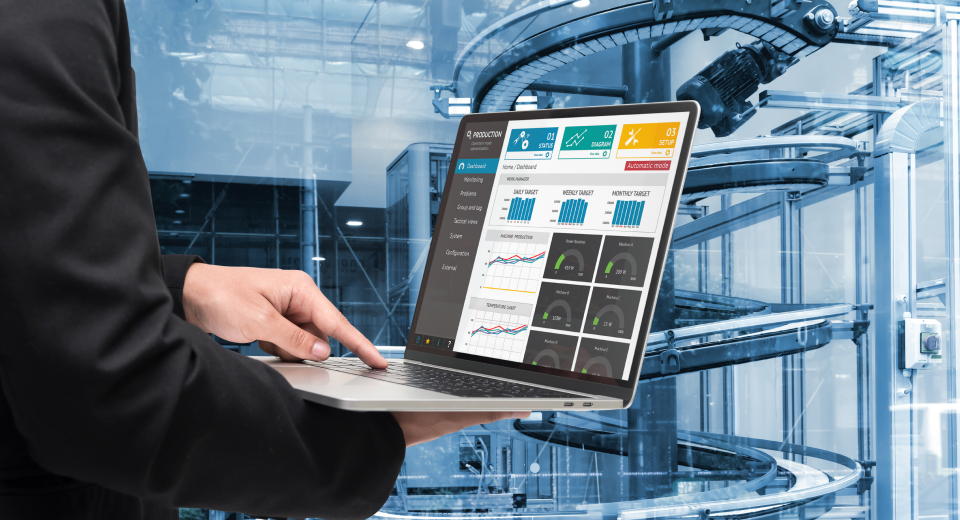Innovating is a long-term goal for LGS, but also a target for every daily activity. It means offering ever higher quality, honing skills, improving the services offered, promoting a sustainable culture, and adopting digital transformation to modernise processes on all levels. Only in this way can new value be generated.
Energy monitoring system
Energy monitoring system
The Group’s centralised energy monitoring system involves a network of over 1,000 smart meters installed at the more energy-intensive sites, covering over 70% of Italian energy requirements. This platform is one of the widest infrastructures developed in Italy by an industrial organisation: during the Covid-19 emergency, it helped check that consumption was in line with the current situation, supporting the identification and implementation of initiatives to improve efficiency.
Building Management System
An assessment is under way for the implementation of two new systems for the management of system assets and their life-cycle.
The Building Management System (BMS), which helps remotely control and monitor systems and mechanical and electrical equipment in buildings in a more efficient way.
Predictive Maintenance, aimed at continuous monitoring of systems to identify any malfunctions and faults before they happen, avoiding any possible production downtime.
Building Management System
Demand Response Programme

The Demand Response Programme is an innovative initiative promoted by the European Commission to encourage active participation in the electricity system from commercial and industrial end consumers, avoiding the construction of new power plants, and reducing or increasing their energy consumption, in response to spikes in demand and the supply of the electricity market. It therefore helps make the electricity grid more stable, increasing its efficiency. This initiative requires that sites adjust their energy load by increasing or reducing it depending on the specific requests from Terna, with only fifteen minutes’ notice. Two of the Group’s sites are currently taking part in the Programme for a total power output of 4.6 megawatts made available to the Italian electricity grid.
RPA - Robotic Program Automation

In line with the Group’s digital transformation process, LGS has launched various Robotic & Intelligence Automation projects for procurement processes.
Repeat purchases with low added value are increasingly entrusted to robots (Bot Buyers) which, by using RPA technologies, turn simple purchase requests into purchase orders, submitting them for checks from buyers before they are signed by LGS agents.
Whitin the LGS procurement processes, there are currently 11 Buyer Bots and 7 Lead Buyer Bots implemented to manage purchase requests related to both indirect and standard direct categories. Their use has been gradually increased over the past few years. Since the start of the project, the Bots have managed a total purchase value exceeding €620 million and more than 9,800 order positions.
The use of Bot Buyers is optimising management times even further for repeat orders and LGS is studying the expansion of RPA technology into other areas of procurement processes that involve repetitive activities, so that buyers can focus on work with a greater added value.
The LGS procurement automation process is only just beginning…
SIRE Platform (Real Estate Information System)

To manage the entire life-cycle of real estate assets and any related services, LGS already implemented an integrated platform several years ago now (IWMS - Integrated Workplace Management System) aimed at reducing process management costs, at maximising productivity and at improving the efficiency of suppliers’ control and management.
With a view to innovation and continuous improvement, the following initiatives are currently being implemented:
- use of the platform from mobile devices (the development of an app) to encourage a quicker, easier and more immediate user experience and to digitise new company processes
- tagging and geolocation of system assets which, alongside making the process quicker and easier for the identification of assets and for their identification on plans, leads to an improvement in system compliance and the integration of information required to create a Digital Twin
- gradually extending the areas managed in a more integrated way (for example, energy, the environment and the management of spaces)
BIM (Building Information Model)
An assessment is under way aimed at evaluating the impact on organisation and processes following LGS’s switch to the BIM, i.e. the introduction of an operational methodology for planning, designing, creating and maintaining a real estate asset. This methodology uses a dynamic, interdisciplinary and shared information model, a Digital Twin, which contains data on the geometry, materials, load-bearing structure, thermal characteristics and energy performances, systems, costs, safety, and maintenance.
BIM (Building Information Model)
Digital storage and management of documents
Digital storage and management of documents
LGS is by Leonardo’s side in the digital transformation process for the management of digital documents too. The digitisation of paper materials and the regulation of digital native documents are fundamental elements for the development of Leonardo’s document management model, supported by platforms and systems that guarantee its overall security, including: regulatory compliance, technological obsolescence and privacy. The use of modern technologies, such as machine learning and artificial intelligence, will help optimise digital archive and documentation processes.

